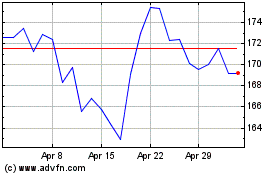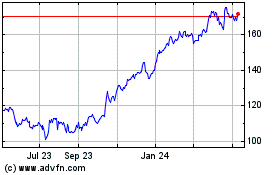Allstate Profit Falls On Investment Losses, Write-Downs
August 04 2010 - 5:14PM
Dow Jones News
Allstate Corp. (ALL), the largest publicly traded home and auto
insurer in the U.S., said profit fell 63% as the company recorded
investment losses on derivatives and wrote down the value of
securities in its portfolio.
But operating profit, which excludes some investment results,
rose about 50% and beat the estimates of analysts who had predicted
that disaster claims from midwestern storms would cut into
profit.
Disaster costs fell to $636 million from a record $818 million a
year earlier. But catastrophe claims were still above average for
the second quarter.
Net income was $145 million, or 27 cents a share, compared with
$389 million, or 72 cents, a year earlier. The insurer had a net
realized capital loss for the second quarter of $451 million before
taxes, compared with a net realized capital gain of $328 million.
Its derivatives portfolio was responsible for the majority of the
$779 million difference, and the firm said it had write-downs
related to residential and commercial-real-estate investments.
Analysts began cutting their estimates on Allstate after rival
insurer Travelers Cos. (TRV) reported record disaster costs when it
released second-quarter results last month. In mid-July, analysts
surveyed by Thomson Reuters expected Allstate to earn an operating
profit of 92 cents a share, but that had fallen to 69 cents by the
time the firm said Wednesday that it had an operating profit of 81
cents.
The company has stepped up efforts to raise prices and pare back
the number of houses it covers in some states to turn a profit in
its homeowners business. On one level, that strategy shows signs of
paying off: the average premium it is collecting on each policy
rose even as the number of policyholders fell. But for every dollar
it collected from customers, it spent almost $1.04 on claims and
expenses. It was the fourth time in the last six quarters that the
homeowners business spent more than it took in.
The disaster costs were tied to 30 separate events in the second
quarter. Brutal hailstorms plagued Oklahoma, while massive
thunderstorms hit Michigan, Ohio and Illinois. And Tennessee was
immersed under record floodwaters that swamped the Grand Ole
Opry.
The only insurer that sells coverage on more homes that Allstate
is State Farm Mutual Automobile Insurance Co., and that company
said in late July that it had paid $1.9 billion in losses on
second-quarter disasters to date. Both companies tend to have a
greater share in the homeowners market in states located away from
the East and West coasts of the U.S.
Allstate and other property insurers face the prospect of
further disaster costs with the peak of the 2010 Atlantic hurricane
season still to come. Forecasters have predicted this year's season
will be an active one.
Allstate gets a larger portion of its revenue from its
auto-insurance operation, which has been a steady source of profit.
The unit helped underwriting income to reverse from a $3 million
loss in 2009 to a $207 million profit in this year's second
quarter.
But the auto unit has also been losing customers, and the number
of policyholders with Allstate's standard auto coverage fell for
the 10th straight quarter. The customers that have stayed with
Allstate has remained essentially steady at about 89% in that time.
Some smaller rivals, including Progressive Corp. (PGR), have been
adding customers while Allstate lost them.
-By Erik Holm, Dow Jones Newswires; 212-416-2892;
erik.holm@dowjones.com
Allstate (NYSE:ALL)
Historical Stock Chart
From Jun 2024 to Jul 2024

Allstate (NYSE:ALL)
Historical Stock Chart
From Jul 2023 to Jul 2024
